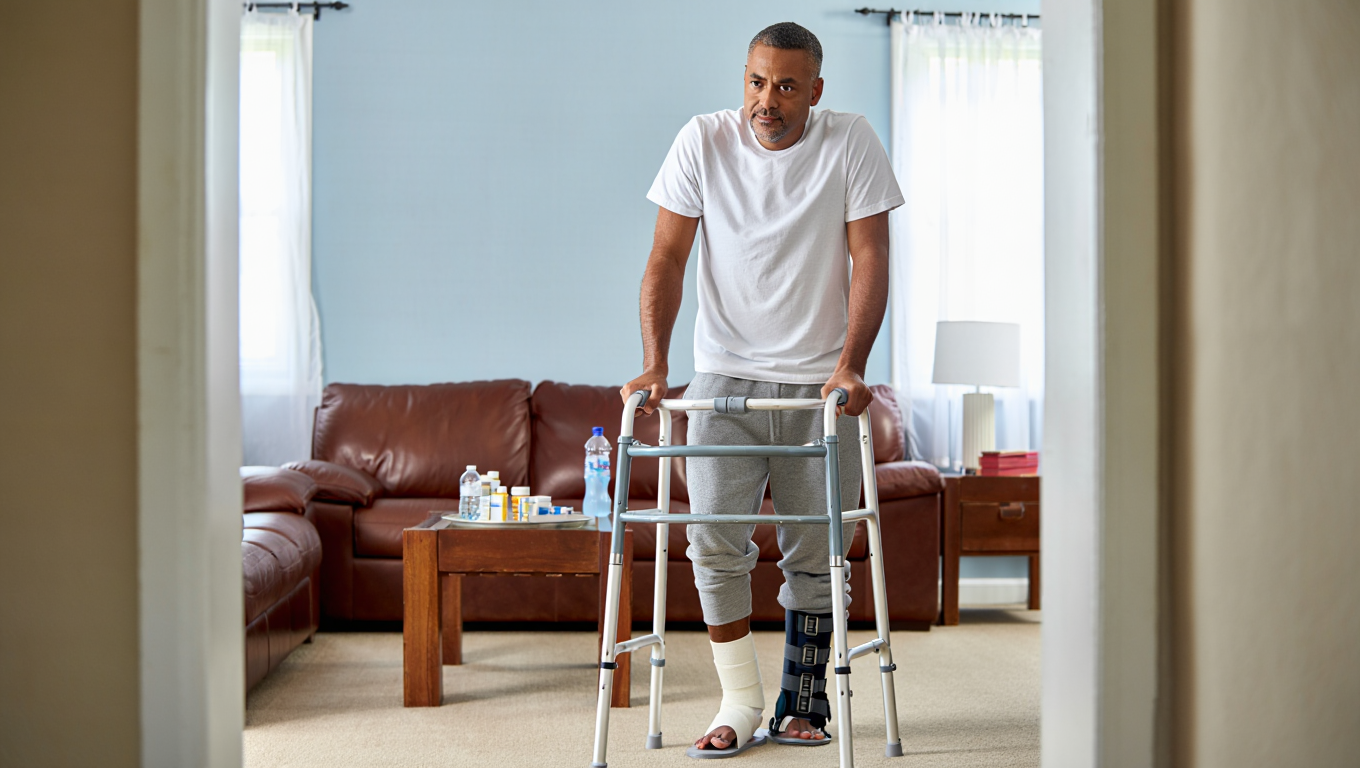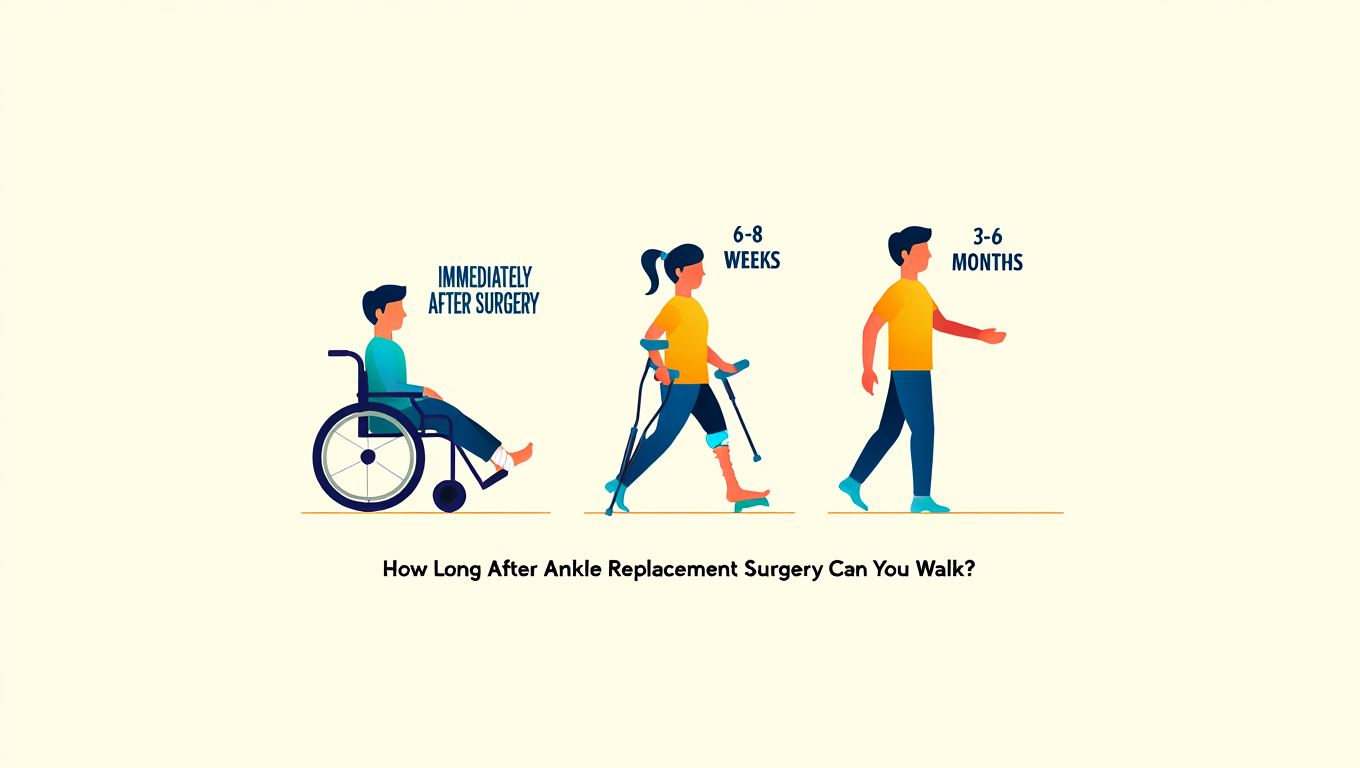Ankle replacement surgery offers hope for patients suffering from severe ankle arthritis, but the journey to full recovery requires patience, dedication, and the right rehabilitation approach. Understanding your ankle replacement recovery time and what to expect during each phase can make the difference between good and excellent outcomes.
For the nearly 5,000 Americans who undergo ankle replacement surgery annually, knowing when you can walk again and how physical therapy supports healing becomes crucial for setting realistic expectations and achieving optimal results.

What is Ankle Replacement Recovery?
Ankle replacement recovery is a structured healing process that typically spans 6-12 months, involving careful progression from complete rest to full functional mobility. Unlike other joint replacements, ankle recovery requires special attention to gait mechanics and balance due to the ankle's critical role in walking stability.
The recovery process involves three distinct phases: immediate healing (0-6 weeks), progressive rehabilitation (6-16 weeks), and advanced functional training (4-12 months). Each phase has specific goals, restrictions, and milestones that guide your return to normal activities.
Modern ankle replacement techniques have improved significantly, with success rates exceeding 90% when patients follow proper recovery protocols. However, the complexity of ankle biomechanics means that rehabilitation quality directly impacts long-term outcomes.
Understanding Ankle Replacement Surgery Recovery Time
Immediate Recovery Phase (0-6 Weeks)
The first six weeks focus on surgical site healing and preventing complications. Your ankle remains immobilized in a cast or specialized boot, with strict non-weight-bearing restrictions for the first 2-4 weeks.
During weeks 2-6, you'll transition to a walking boot with gradual introduction of protected weight-bearing. Pain management, swelling control, and wound care dominate this phase, while basic ankle pumping exercises help maintain circulation.
Progressive Rehabilitation Phase (6-16 Weeks)
This critical period determines much of your long-term success. Formal ankle replacement physical therapy begins, focusing on range of motion restoration, strength building, and gait training. Most patients transition from assistive devices to independent walking during this phase.
The ankle replacement recovery time varies significantly between individuals, but most patients achieve basic walking independence between weeks 8-12. Factors like age, pre-surgery condition, and therapy compliance heavily influence this timeline.
Advanced Recovery Phase (4-12 Months)
Long-term recovery focuses on optimizing function, building endurance, and returning to desired activities. While basic walking returns earlier, achieving full ankle replacement recovery time requires months of continued improvement.
Many patients report continued gains in comfort and function throughout the first year, with some improvements extending into the second year post-surgery.
How Long After Ankle Replacement Surgery Can You Walk?
The question "how long after ankle replacement surgery can you walk" doesn't have a one-size-fits-all answer, but clear milestones help set expectations.

Walking Milestones Timeline
Week 2-4: Protected weight-bearing begins with walker or crutches. This isn't true walking but controlled movement to prevent muscle loss.
Week 6-8: Short-distance walking with boot and assistive devices typically becomes possible. Patients often manage household distances at this stage.
Week 8-12: Independent walking without crutches usually develops, though a supportive boot may remain necessary. Walking endurance gradually improves.
Month 3-6: Normal walking patterns return for most patients, with continued improvements in speed, balance, and confidence.
Factors Affecting Walking Recovery
Several variables influence when you'll walk normally again:
Patient factors include age, overall health, bone quality, and pre-surgery activity level. Surgical factors involve implant type, technique used, and any complications. Recovery factors encompass therapy compliance, home environment, and support systems.
Realistic expectations help maintain motivation during challenging recovery periods. While some patients walk independently at 8 weeks, others may need 12-16 weeks to achieve the same milestone.
The Critical Role of Ankle Replacement Physical Therapy
Ankle replacement physical therapy serves as the foundation of successful recovery, addressing not just strength and motion but also the complex neuromotor patterns required for normal walking.
Early Phase Therapy Goals
Initial therapy focuses on controlling inflammation, maintaining joint mobility, and preventing complications. Gentle range-of-motion exercises, circulation activities, and pain management techniques form the treatment foundation.
Therapists also begin educating patients about proper gait mechanics and introducing assistive devices. This early education proves crucial for preventing compensatory movement patterns that can cause long-term problems.
Progressive Therapy Techniques
As healing progresses, therapy intensifies to include strength training, balance work, and functional movement patterns. Advanced techniques like proprioceptive training and gait analysis help optimize walking mechanics.
Modern rehabilitation often incorporates technology-assisted training, biofeedback systems, and specialized equipment designed to accelerate recovery while protecting the healing ankle.
Home-Based Rehabilitation Strategies
Successful ankle replacement recovery extends beyond clinic visits. Home exercise programs, activity modification strategies, and self-monitoring techniques empower patients to take active roles in their recovery.
Creating a supportive home environment with appropriate equipment, safety modifications, and family involvement significantly impacts recovery outcomes.
Advanced Rehabilitation Technology: The Just Walk Solution
Revolutionary Approach to Ankle Recovery
The Just Walk™ neuromotor rehabilitation system represents a breakthrough in ankle replacement recovery, offering targeted gait training that addresses the specific challenges ankle replacement patients face.
This innovative 3-pound wearable device provides mechanical assistance and resistance training that adapts to different recovery phases. Unlike traditional therapy equipment, Just Walk enables functional training during real-world activities like walking, stair climbing, and daily movements.
How Just Walk Differentiates from Traditional Methods
- Functional Integration: While conventional therapy often occurs in clinical settings with artificial exercises, Just Walk allows patients to practice actual walking and daily activities while receiving therapeutic benefit.
- Neuromotor Specificity: The device's magnet-driven resistance system specifically addresses the neuromotor challenges ankle replacement patients experience, helping retrain proper movement patterns that surgery may have disrupted.
- Home-Based Intensity: With proven effectiveness in just 15-20 minute sessions twice daily, patients can maintain intensive rehabilitation at home, extending recovery benefits beyond traditional clinic schedules.
- Progressive Adaptation: Four adjustable resistance levels allow the system to evolve with patient progress, providing appropriate challenge throughout different recovery phases without risking implant integrity.
- Practical Benefits for Ankle Replacement Patients
- Just Walk addresses three critical aspects of ankle replacement recovery: gait normalization, strength building, and balance improvement. The system's mechanical assistance helps patients overcome early walking difficulties while building confidence in their new ankle.
- Clinical studies demonstrate significant improvements in walking speed, balance confidence, and functional independence among users. For ankle replacement patients, this translates to faster return to daily activities and reduced long-term complications.
- The device particularly benefits patients during the 8-16 week recovery window when transitioning from assisted to independent walking. This critical period often determines long-term walking quality and patient satisfaction.
Tips for Optimizing Your Recovery
Pre-Surgery Preparation
- Preparing for ankle replacement recovery begins before surgery. Physical conditioning of surrounding muscles, home environment modifications, and education about the recovery process set the foundation for success.
- Consider scheduling pre-surgery physical therapy to strengthen hip and knee muscles that will compensate during early recovery. Arrange for assistance with daily tasks and modify your living space for limited mobility periods.
During Recovery Best Practices
- Strict adherence to weight-bearing restrictions prevents complications that could significantly extend recovery time. Follow medication schedules precisely, attend all therapy appointments, and communicate openly with your healthcare team about progress and concerns.
- Nutrition plays a crucial role in healing. Focus on adequate protein intake (1.2-1.6g per kg body weight), essential vitamins and minerals, and anti-inflammatory foods that support tissue repair.
Long-Term Success Strategies
- Maintaining ankle replacement success requires ongoing attention to activity choices, weight management, and regular medical follow-up. Low-impact exercise routines help preserve implant longevity while maintaining fitness.
- Develop awareness of your ankle's capabilities and limitations. While most patients achieve excellent function, high-impact activities may require modification to protect the implant long-term.
Summary and Next Steps
Ankle replacement recovery is a journey that requires patience, dedication, and expert guidance. Understanding the timeline, committing to comprehensive rehabilitation, and utilizing advanced tools like the Just Walk system can significantly enhance your recovery experience.
Remember that every patient's recovery is unique. While general timelines provide guidance, your individual experience may vary based on multiple factors. Working closely with your healthcare team and maintaining realistic expectations will help you achieve the best possible outcomes.
Ready to optimize your ankle replacement recovery?
Speak with your physician about incorporating advanced rehabilitation technologies into your treatment plan, and explore how the Just Walk system might benefit your specific situation.
FAQs
?How long does ankle replacement recovery take compared to other joint replacements
Ankle replacement typically requires 6-12 months for full recovery, similar to hip replacement but potentially longer than knee replacement due to the ankle's complex biomechanics and critical role in balance.
?Can I drive after ankle replacement surgery
Driving restrictions depend on which ankle was replaced and your vehicle's transmission type. Most patients can resume driving 6-10 weeks post-surgery once they can safely operate pedals and walk without assistive devices. Always get medical clearance first.
?What activities should I avoid after ankle replacement
High-impact activities like running, jumping, and contact sports should generally be avoided to protect implant longevity. Low-impact activities like walking, swimming, cycling, and golf are typically encouraged once recovery is complete.
?How do I know if my ankle replacement recovery is progressing normally
Normal recovery includes gradual pain reduction, progressive increase in walking distance, improved range of motion, and decreasing swelling. Contact your healthcare provider if you experience increasing pain, signs of infection, or significant setbacks in function.
Sources
- American Academy of Orthopaedic Surgeons. "Total Ankle Replacement." OrthoInfo. 2023.
- Foot & Ankle International Journal. "Outcomes and Complications of Total Ankle Arthroplasty: A Systematic Review." 2022.
- Journal of Bone and Joint Surgery. "Long-term Results of Total Ankle Replacement." 2023.
- Physical Therapy Journal. "Rehabilitation Protocols Following Total Ankle Replacement." 2022.
Important
This article is for informational purposes only and is not a substitute for professional medical advice; always consult your doctor or physical therapist before starting any exercise or using any device.



